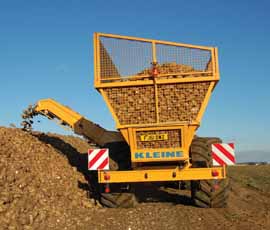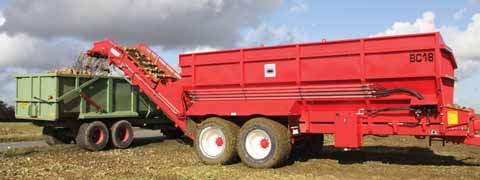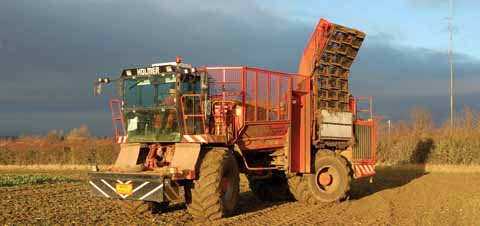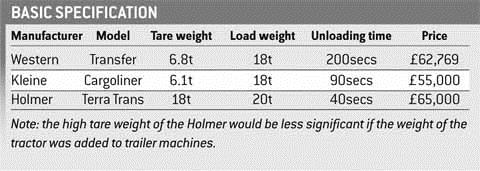Big beet chaser bins growing in popularity

Chasers bins (also known as transfer wagons) are not an entirely new entity; they’ve been charging around enormous Australian and North American fields transferring grain from combines to road trucks for years. They’ve proved less popular in Europe, but farmers here are beginning to look at their benefits for the sugar beet harvest.
Muddy wheels and heavy loads means tracks don’t last long, so the appeal of keeping the mud in the field is attractive.
There are other benefits of running a chaser bin, too. With all the mud kept in the field, it saves the need for a tractor and sweeper and gives conventional tractors the time to travel bigger distances to concrete pads or clamps that make more good storage and loading sites. Lorries can even be loaded directly.
Trailed chaser bins

James Forest of RH Forest and Sons, Stonham Aspal, has run a Richard Western beet chaser (pictured above) for the past three years. Having bought the second of three chaser bins sold by the Suffolk manufacturer, Mr Forest chose to add a longer elevator and mudguards.
He says a third axle or fitted tracks would also help, but admits there’s a balance between functionality and cost.
“I’m keen on tracks and would like to see this machine on tracks” says Mr Forest. “But they would probably need to be powered, which would add considerable cost.”
Using the chaser – pulled by a Challenger 765 – means up to three 18t trailers are kept busy at peak times, unless conditions are tricky, when they are replaced by smaller, 10t units. One downside is the two-minute unloading time of the Western, something Mr Forest thinks could be improved.
Other companies offering chaser bins include Kleine of Germany (pictured top right) and Swedish firm Edenhall. The first batch of Kleine’s single-axle Cargoliner will arrive in the UK soon. With 40 already sold on the continent, the maker has reported an upsurge in interest.
The 18t trailer uses a side discharge chute, which provides an even heap for the loader and means the trailer does not run on the loading area.
Self-propelled chasers

The alternative to a towed chaser is a self-propelled version, with a dedicated driver and machine replacing a range of tractors and trailers. Wickham Beet Harvesters, a cooperative based in Woodbridge, Suffolk, chose a self-propelled machine after a wet 2010 harvest and the need to replace its Holmer Terra Dos harvester.
Holmer has refurbished about 40 old Terra Dos machines (pictured above) and the cost of the cooperative’s secondhand Terra Transport with 18t capacity worked out at little more than a specialised trailer.
“We looked at trailed machines, but you still have to put an expensive tractor on the front,” says the cooperative’s director, Grahame Taylor.
The £65,000 machine is fitted with 900-section front and 1,050-section rear tyres to help reduce ground compaction, which has prompted several growers to earmark beet on land previously thought unsuitable.
With most of Wickham Beet Harvesters’ beet loaded with a self-propelled Maus-type beet loader, heaps are said to be easier to work with and the Holmer is able to fill clamps higher and more level without additional work.
Phil Stebbing operates the Wickham Holmer and is impressed. “They’ve taken out all the heavy parts, but you’ve still got the Terra Dos steering. It’s fast around the field and one fuel fill will keep me going for three days”.
The big MAN 420hp engine ticks over at low revs for most of the day and, with the engine at the rear, the cab is surprisingly quiet.
Advantages of a beet chaser bin
• Reduction in soil compaction
• Ability to keep moving in difficult conditions
• Keeps mud off the road
• Works well with self-propelled beet loaders

To see a video of the Kleine and Holmer machines in action visit Power Farming.

